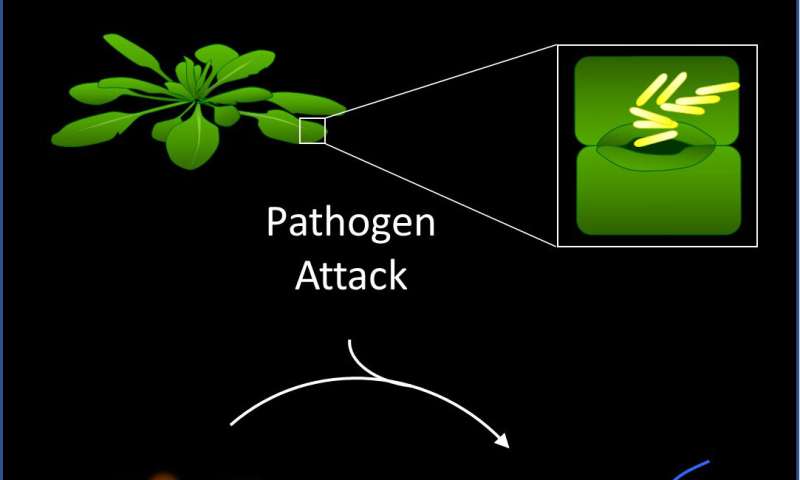
To ensure survival, living organisms are equipped with defensive systems that detect threats and respond with effective counter measures.
Plants are known to mount quick defenses against a variety of threats—from attacking insects to invading pathogens. These intricate immune response mechanisms operate through a complex network that plant biologists have sought to untangle.
Crucial to these defenses is the timing and duration of immune responses. Humans are equipped with a strong and rapid inflammation response that is essential to ward off disease, but chronic and persistent inflammation can be harmful to our health. Similarly, plants feature defenses that are timed for rapid and effective responses against pathogens, yet tightly controlled to avoid threatening the host organism.
Keini Dressano, Alisa Huffaker and their colleagues at the University of California San Diego's Division of Biological Sciences have discovered a critical "on-off" switch in the plant immune response system. As described July 20 in their report published in Nature Plants, they identified a new regulatory switching mechanism—an RNA-binding protein—that helps turn on immune responses a few minutes after attack. Hours later, the switch follows with a deactivation "off" signal to avoid self-inflicted damage to the plant.
"These findings have provided new insights into how the complex intricacies of plant immune responses are orchestrated to successfully fight off pathogens, and lay a path forward for improving plant disease resistance to ensure future food stability," said Huffaker, an assistant professor in the Section of Cell and Developmental Biology.
The novel switch was found in Arabidopsis plants to control splicing of mRNA transcripts that encode signaling protein regulators of the plant immune response. To turn immune defenses on, the researchers say, a simple chemical modification of the RNA-binding protein reverses mRNA splicing that normally keeps immune responses deactivated. To turn the immune response back off, a second chemical modification of the RNA-binding protein returns mRNA splicing to "normal," and the immune response is back to being held in check.
"This work went beyond simply identifying a new regulator of plant immunity," said Huffaker, of the detailed mechanisms uncovered. "We discovered specific chemical modifications that control regulatory function, transcriptional targets of the regulator, differential splicing of the targets and precise effects of splicing on both target function and overall plant immune responses and disease resistance."
Keini Dressano et al, Dynamic regulation of Pep-induced immunity through post-translational control of defense transcript splicing,
Nature Plants(2020).
DOI: 10.1038/s41477-020-0724-1Citation: Novel 'on-off' switch discovered in plant defenses (2020, July 22) retrieved 25 July 2020 from https://ift.tt/2WMRKrp
This document is subject to copyright. Apart from any fair dealing for the purpose of private study or research, no part may be reproduced without the written permission. The content is provided for information purposes only.
from Hacker News https://ift.tt/2WMRKrp
No comments:
Post a Comment
Note: Only a member of this blog may post a comment.